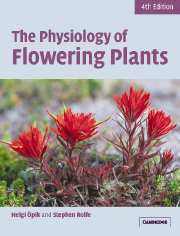Book contents
- Frontmatter
- Contents
- Preface
- Chapter 1 Introduction
- Part I Nutrition and transport
- Part II Growth and development
- Chapter 6 Growth as a quantitative process
- Chapter 7 Plant growth hormones
- Chapter 8 Cell growth and differentiation
- Chapter 9 Vegetative development
- Chapter 10 Photomorphogenesis
- Chapter 11 Reproductive development
- Chapter 12 Growth movements
- Chapter 13 Resistance to stress
- Appendix
- Index
- References
Chapter 9 - Vegetative development
Published online by Cambridge University Press: 05 June 2012
- Frontmatter
- Contents
- Preface
- Chapter 1 Introduction
- Part I Nutrition and transport
- Part II Growth and development
- Chapter 6 Growth as a quantitative process
- Chapter 7 Plant growth hormones
- Chapter 8 Cell growth and differentiation
- Chapter 9 Vegetative development
- Chapter 10 Photomorphogenesis
- Chapter 11 Reproductive development
- Chapter 12 Growth movements
- Chapter 13 Resistance to stress
- Appendix
- Index
- References
Summary
Introduction
As described in Chapter 8, plant growth results from a combination of cell division, elongation and differentiation, initiated from groups of cells known as meristems. During embryogenesis two meristems are formed – the shoot apical meristem which gives rise to the shoot system, and the root apical meristem which forms the root system. As these primary meristems develop, they give rise to more apical meristems which will form side branches or lateral roots, and lateral meristems which result in an increase in girth (Fig. 9.1).
Together, environmental and internal signals control the rate of growth, the activation of new meristems, and the differentiation of cells and tissues, producing the plant body within the framework of the basic ‘body plan’ of the plant. Meristem activity must be under precise control to generate the specific structures of the plant, but at the same time must be flexible enough to respond to environmental signals. Some of the controlling signals, and the genetic systems on which they act, are discussed below, with reference to the formation of the vegetative organs of the plant. The formation of reproductive structures is covered in Chapter 11.
The structure and activity of the shoot apical meristem
Organ initiation
During the vegetative phase of growth, the shoot apical meristem (SAM) produces stem, leaves and axillary buds in units known as phytomers.
- Type
- Chapter
- Information
- The Physiology of Flowering Plants , pp. 221 - 245Publisher: Cambridge University PressPrint publication year: 2005



